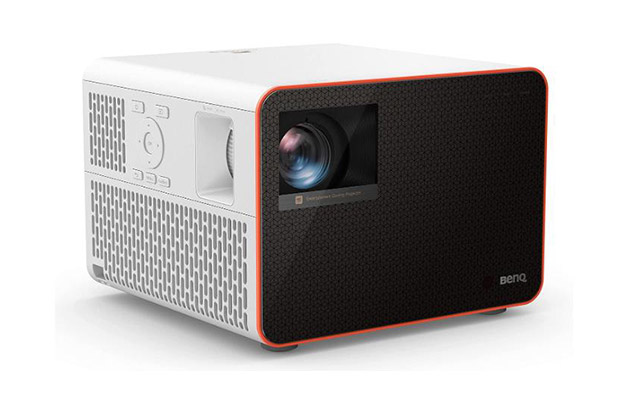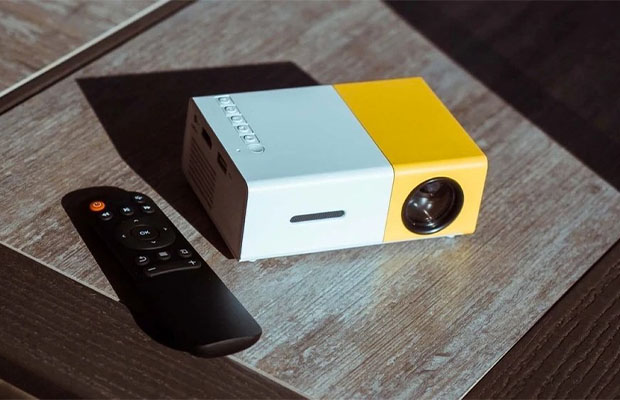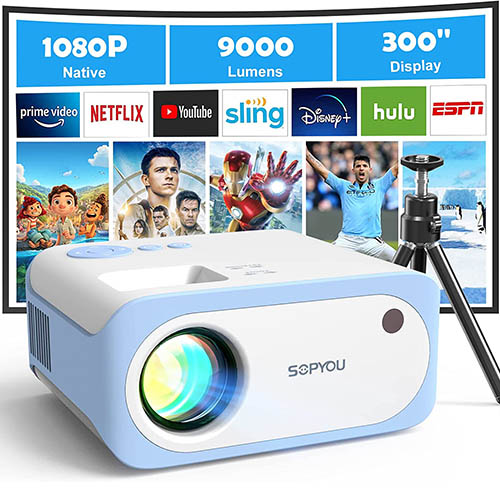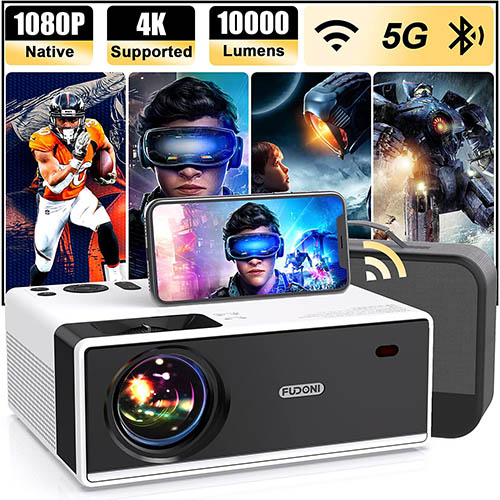In this BenQ X3000i Projector review, you can know about a fantastic gaming projector.
With a wealth of features and an impressive price of $1,999, the BenQ X3000i is a fantastic gaming projector. The significant light loss from using a wide color gamut and some visible rainbows for sensitive viewers detract from the movie and television experience, even though its HDR performance is better than projectors with comparable prices.
Table of Contents
Overview
In March 2022, the X3000i went on sale to the general public.
The Manufacturer’s Suggested Retail Price (MSRP) of the BenQ X3000i is $1,999. In March 2022, the general public could purchase the X3000i. Nevertheless, I had the good fortune to use the X3000i for a brief gaming session in January 2022 while at CES 2022, where the projector was unveiled.
100% of the DCI-P3 color gamut can be reproduced by the X3000i’s 4LED light source, which has a brightness rating of 3,000 ANSI lumens. The light source should also last up to 30,000 hours in Eco Mode and 20,000 hours in Normal Mode, according to BenQ.
Input lag is one of a few things that are crucial to us gamers. According to BenQ, the range of acceptable input lag is 0–20 ms, 20–40 ms, 40–62 ms, and anything less than 63 ms is considered to be extremely slow. The X3000i has an input lag of 4K/60Hz @ 16.67ms, 1080p/240Hz @ 4.16ms, 1080p/120Hz @ 8.33ms, and 1080p/60Hz @ 16.67ms, according to BenQ ratings.
It is important to distinguish the BenQ X3000i 4LED gaming projector from the BenQ X1300i 4LED gaming projector. The X3000i costs $1,999, which is $700 more than the X1300i gaming projector’s list price of $1,299 The X3000i costs more because of a few significant differences between the two projectors.
To start, the X3000i and X1300i are 4K and 1080p projectors, respectively. The X3000i can show a 4K image thanks to its XPR Technology. According to BenQ, XPR Technology produces 8.3 million distinct pixels, regardless of the DMD chip’s native pixel count, to achieve true 4K. In order to create true 4K, 8.3 million pixels with lightning-fast pixel shifting speed, XPR quadruples the 0.47-inch DMD chip’s native 1920×1080 pixels.” Be sure to check out the 4K DLP with XPR Technology Glossary on Projector Reviews for more information.
Additionally, the X3000i and X1300i both come with built-in versions of Android, 9.0 and 10.0 respectively. BenQ’s CinematicColor Ultra-Reality, with 100% DCI-P3 color gamut coverage, is available on the X3000i, while CinematicColor, with 98% Rec. 709 color gamut coverage, is available on the X1300i. More colors are visible in movies and your gaming environment the wider the color gamut.
The 1.3x zoom lenses on the X3000i and X1300i have throw ratios of 1.15 to 1.5 and 1.13 to 1.56, respectively, for their respective magnifications. The X3000i projects an image of 100 inches at a distance of 8.2 feet and one of 150 inches at a distance of 12.5 feet from the projection surface, while the X1300i projects an image of 100 inches at a distance of 9.45 feet and one of 150 inches at a distance of 14.11 feet. The preferred projector image size for the X3000i is between 60 and 200 inches. Page 14 of the user manuals for both projectors states that the preferred image size for the X1300i is between 60 and 150 inches. Philp Boyle’s comprehensive review of the BenQ X1300i can be found by clicking here if you’d like to learn more about this product.
Highlights
- MSRP – $1,999
- Technology – Single DLP chipset; Texas Instruments Digital Micromirror Device (DMD)
- 3840×2160 4K UHD displayed resolution
- Brightness (Manufacturer Claimed) – 3,000 ANSI lumens
- 4K@60Hz: 16.67ms input lag
- 1080p@240Hz: 4.16ms input lag
- HDR Game mode
- HDR10 compatible
- 100% DCI-P3 color gamut coverage
- BenQ HDR-PRO™ & Dynamic Black Technology
- Powered by Bongiovi DPS technology w/ virtual 3D surround sound
- Dual HDMI 2.0b HDCP 2.2 ports
- HDMI port two supports eARC, allowing Dolby Atmos and 7.1-channel audio to pass-through
Pros
- 4LED light source rated at 3,000 ANSI lumens
- BenQ’s unique gaming modes
- Great 3D performance
- Covers 100% of DCI-P3 with WCG setting
- Competitive price
Cons
- Wide gamut setting decreases HDR light output
- Black level a little high
- Rainbows might be visible to those sensitive to them
Design
For those who are familiar with the X1300i model from the company’s past, the x3000i has a sleek, contemporary design and looks strikingly similar to it. But make no mistake, the X3000i is not a small device. It weighs 14.1 pounds and has dimensions of 10.7 x 7.8 x 10.2 inches (excluding the adjustable feet), so you’ll need to make sure you have enough room for it on the surface you want to set it on or enough clearance for your screen if you want to mount it to the ceiling (which I’ll cover in more detail later).
Its cube-like shape, black front, and white case on the other sides, along with fashionable vents that wrap around the projector’s sides, add to its straightforward yet amusing design. All of the ports are located on the back for easy access, and the side has dials for the manual zoom and focus in addition to settings and navigation controls.
A wireless Android TV adapter is included with the projector. However, you won’t be able to plug in the pocket-knife-sized adapter until you remove the projector’s top and remove two screws. Despite being a minor hassle, you only need to complete it once, and it only takes a few seconds. I appreciate that BenQ included an Android TV adapter rather than choosing a built-in operating system, which might become sluggish over time. Additionally, the adapter can be upgraded in future models.
Additionally, it includes hardware for mounting the projector upside down for those who want to do so, as well as adjustable feet, a power cord, and remote batteries. The projector and Android TV interface navigation buttons are available on the compact remote control that comes with the device. A dedicated button is provided for accessing Prime Video, Google Assistant, D-pad navigation, volume/mute, home, back, settings, and the main projector menu. I didn’t experience any missing buttons because they were all sufficiently big, simple to press, and responsive.
The lamp life of the projector is 20,000 hours when in Normal mode or SmartEco mode, and it increases to 30,000 hours when in regular Eco mode. If you use the projector for an average of five hours a day, this equates to well over ten years of enjoyment.
Setup
The projector’s design is largely plug-and-play, so getting it ready to use didn’t take very long. It was prepared to party after I opened the box and connected the Android TV adapter. Especially if it will just be placed on a table, the typical user shouldn’t have any problems with this step of the process.
Its picture color, as well as its brightness and contrast, seemed reliable considering that it was brand new out of the box. I don’t believe the typical user will need to adjust the image, but more experienced users might want to, and thankfully this projector makes it simple to do so. Focus and keystoning were the only settings I thought needed adjustment, and I also disabled True Motion (because it’s the worst) in addition to those two settings.
The projector can be mounted upside-down to your ceiling or set up on a flat surface, such as a table, counter, or bookshelf. BenQ comes with all the necessary hardware for that. The X3000i does have a 110% vertical offset, though, and that is important to note. This implies that the image produced by the lens does not emerge directly. Instead, it leans slightly downward; to get it to line up properly, you might need to slightly lower your screen. The projector can support both vertical and horizontal keystoning, but doing so could affect latency.
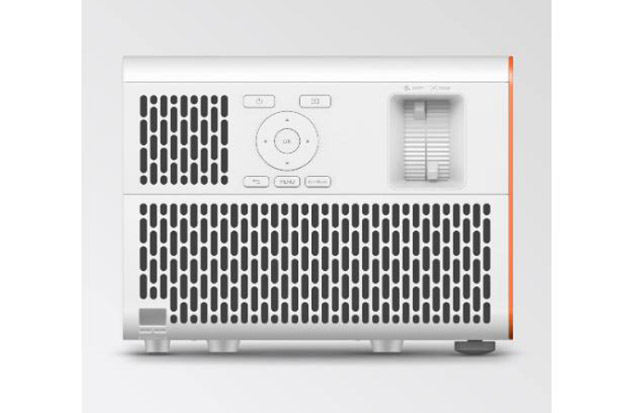
Ports & Connectivity
The X3000i is generously sized and as a result has room for a number of ports, dials, streaming sticks, and other accessories. In addition, as we already mentioned, the included QS01 Android TV adapter must be plugged into both the HDMI port and the micro-USB power cable inside the projector.
There are plenty of other ports on the projector’s exterior, and they are all easily accessible. It was simple for me to connect my ROG Zephyrus G15 laptop when I wanted to play some games because it has two HDMI ports (2.0b/HDCP2.2). A 3.5mm Mini Jack audio out port, a DC 12V Trigger (3.5mm Jack), one USB-A (2.0/Power Supply 2.5A/Service), and one RS-232 in (DB-9pin) are also included.
In terms of connectivity, the X3000i supports Wi-Fi 802.11 a/b/g/n/ac and Bluetooth 4.2. For those who enjoy casting videos from a phone or laptop, Chromecast is now available on the device thanks to Android 10.0, which it runs. You’ll have access to numerous well-known video streaming services with the Android TV adapter, including Prime Video, Disney+, ESPN, Tubi, Paramount+, YouTube, HBO Max, and Peacock. For those who want additional apps, such as TikTok, TED Talks, Facebook Watch, Kodi, and Plex, you can also access the Google Play Store.
Simply put, the BenQ X3000i will allow you to get started right away. It is simple to connect to other devices, jump into a game, or find something to watch for family movie night thanks to the Android TV adapter and the projector’s numerous ports.
Image Quality
Although I’ve bought and used a lot of expensive TVs in the past, I haven’t used a lot of mid-range or expensive projectors. Nevertheless, I thought the X3000i’s image quality looked fantastic right out of the box and that nothing was seriously out of balance, dark, or lacking. Most people who choose this projector for their home theater will be pleased with what it offers in terms of picture quality and the fact that they won’t need to make many adjustments.
The X3000i is significantly brighter than projectors with a 3LED system because of its 4LED lamp system. This projector has a solid 3,000 ANSI lumens (with a contrast ratio of 500,000:1), which makes a huge difference. BenQ increased the brightness by adding a fourth blue LED pump inside. Additionally, I never encountered a situation with this model where brightness was sacrificed for color accuracy, as I have with many projectors. It is bright enough to be used during the day or in a room with overhead lights on, but for the best picture quality, I would stick with ambient lighting that is dimmer (or not present at all).
The impressive color accuracy of the X3000i may be the only feature more remarkable than its brightness. This projector is no exception to BenQ’s reputation for producing projectors with excellent color accuracy right out of the box.
When the wide color gamut setting is on, it completely covers DCI-P3, the modern color standardization protocol used for video games and monitors, and has a wider range of colors than sRGB. It also supports both HDR-10 and HDR-PRO tone-mapping technology, so colors will look incredibly vivid and accurate regardless of whether you’re playing Fall Guys online with your friends or watching a dimly-lit scene in literally any fantasy TV program never once appeared drab or overly colorful.
Throughout the majority of my testing, I kept the projection at about 100 inches and positioned it atop a tall bookshelf, about 10 feet from the screen. It supported 2.40:1 and 4:3, but its native aspect ratio of 16:9 looked fantastic. In testing the vertical and horizontal keystone features with the projector moved to the side, I discovered that they were simple to use and simple to fix. I advise against using the keystone feature while playing an online game because it can cause latency to increase. Instead, I suggest doing this when watching YouTube videos or movies.
Speaking of response times, if you aren’t fiddling with the keystone feature, I think you’ll be satisfied with them here. When the gaming mode is turned on, the projector’s native true 4K UHD resolution at 60Hz has a 16ms latency. Similarly, it is cut in half to just 8ms with 1080p at 120Hz and again to 4ms with 1080p at 240Hz. Since latency doesn’t always decrease as framerates increase, the latter achievement is particularly impressive. On the BenQ, I spent hours playing online FPS games without experiencing any lag; everything was always smooth.
I experimented with various placements and throw distances, testing the X3000i’s capabilities at various times of the day and with and without ambient lighting. Unsurprisingly, it consistently hit the ball out of the park. The image was consistently clear, bright, and had true colors. The projector is excellent overall, and my only criticism is that the blacks could be a little richer. However, this is a minor issue given the projector’s $2K price tag. They are genuinely just fine, and the majority of users probably won’t notice a problem right out of the box, but I thought they could be slightly improved (and if you feel comfortable doing so, there are calibration features you can fiddle with to your liking).
Three specific gaming modes are by far the coolest additions BenQ made to the X3000i! There’s RPG, which boosts cinematic colors and sound settings when you play, well, RPG games like Dark Souls; FPS, which makes a sound finder visible on the screen so you can locate your enemies when playing shooters like Halo; and SPG, which boosts things like commentary and the green-ness of the grass while playing sports games like FIFA 22. Although BenQ’s use of the various modes may have seemed like a strange flex, I actually found them to be enjoyable. Better gaming immersion—what’s not to like about that?
Whether I was playing video games, watching Disney movies, or checking my For You page on TikTok, the X3000i never failed to impress. Regarding the image, I never noticed any rainbow effects or other unpleasantness. It’s enjoyable to watch, consistently clear and crisp, and it appears like a TV rather than a projector.
Sound Options
Even if it’s portable and on a table in front of you, built-in sound isn’t the best audio option for a projector. Although it will almost certainly be coming from behind you, a larger projector may make a louder sound.
Placing speakers in a projector behind you is about as unmapped as you can imagine in a market where upward-firing soundbars and screen-emissive TV audio boast of accurately mapping audio to onscreen positions for a greater sense of reality.
However, the brain is skilled at adapting to what it has, so we used a fair amount of informal material in this manner to gauge the speakers’ abilities. Because sitting to one side would make any attempt at stereo ineffective, we were able to sit directly in front of the projector’s ceiling position.
The audio system’s two “5W chamber speakers,” which both project sound from the back of the projector, don’t bother anyone and have even surprised us at times with their effectiveness. The bright fizz of the digital alarm which awakens Ryan Gosling from his flying car doze at the start of Bladerunner 2049 made us jump from our own calmed state invoked by the soporific cityscapes of the opening.
Male dialogue, however, might be muted by the unit’s slight boxiness, which is inexorably “pushed” in the EQ to make up for the lack of any real bass. The sound also doesn’t have a very wide stereo field, even if you press the top center remote button to turn on “dynamic stereo enhancement.”
With Bongiovi’s DPS (Digital Power Station) audio technology, which aims to “simulate dynamic 3D sound, creating an immersive sound experience and a more surrounded, three-dimensional sound effect,” this created a certain openness to soundscapes and soundtrack music without appearing to interfere with understandability.
Not really, no, but it had quite a widening effect in the right circumstances – the bees 1hr42 into Bladerunner 2049 offered a good example of this. There are additional sound settings, including “Cinema,” which “emphasizes deep bass,” “Sports,” which “emphasizes vocals,” and “Virtual Surround Sound,” which “emphasizes virtual surround sound” (but not really).
Getting your sound out of the box is the best thing you can do for it in this situation. Even without headsets connected to the console, gamers might be donning them. Otherwise, we’re happy to see that BenQ has added a digital audio output with two levels in addition to an analogue minijack output.
The HDMI 2 socket has an eARC port that allows you to send up to Dolby Atmos from one HDMI input out to a receiver to the other, although we were unable to test this. The optical output can deliver up to 5.1-channel audio, and it can deliver up to 5.1 audio via optical output.
Use an external source and an external sound system once more for the best audio results. It demands nothing less because of the quality of the projection in this instance. Do it properly.
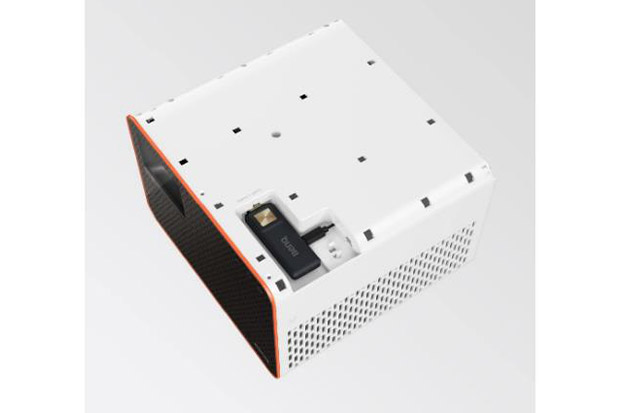
Conclusion
Since I reviewed the X1300i and was aware of the X3000i’s impending release, I’ll be completely honest and say that I have been anticipating reviewing it. The X3000i delivers with the various available gaming options, and the three game modes should be more than enough to pique any gamer’s interest. At a relatively low cost of $1,999, input lag is extremely low, and high refresh rate support with good brightness is pretty impressive. (Yes, it lacks HDMI 2.1 and 4K/120, but the price is something I’ll bring up once more.)
Compared to other projectors priced at $2,000 and under, HDR performance is a little bit better. (Better HDR and black levels can be achieved by upgrading to the Optoma UHZ50, which costs an additional $800, but has a laser light source. It’s unfortunate that the X3000i’s ability to reproduce the entire DCI-P3 color gamut comes at the expense of a significant amount of brightness, even though it’s great that it can do so. You should also take that into account if you are particularly sensitive to rainbow artifacts in this situation.
Nevertheless, despite a few limitations, the BenQ X3000i is a highly appealing choice for gamers. At this cost, it is impossible to find a 4K HDR projector with a solid-state light engine that is as bright and durable as this one.
Read Next: Bold Projector Review

